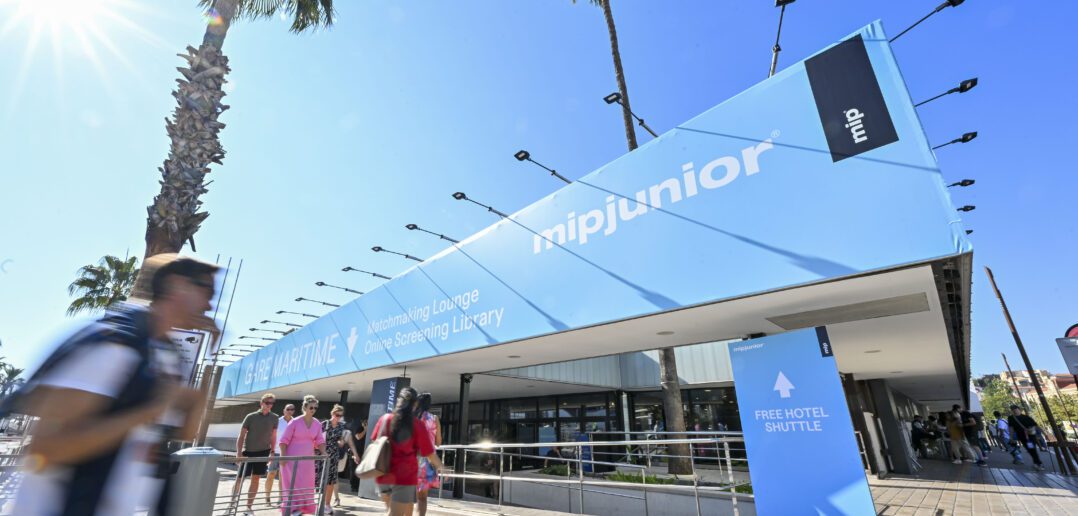Excitement about digital platforms and the creator economy; the importance of tapping into kids’ own creative talents; the looming disruption of GenAI technologies, and one famous giraffe were among the hot topics at MIPJUNIOR this weekend. Two days of thoughtful debate about the kids industry’s future also saw some new and inventive formats put through their paces at the MIPJUNIOR Pitch.
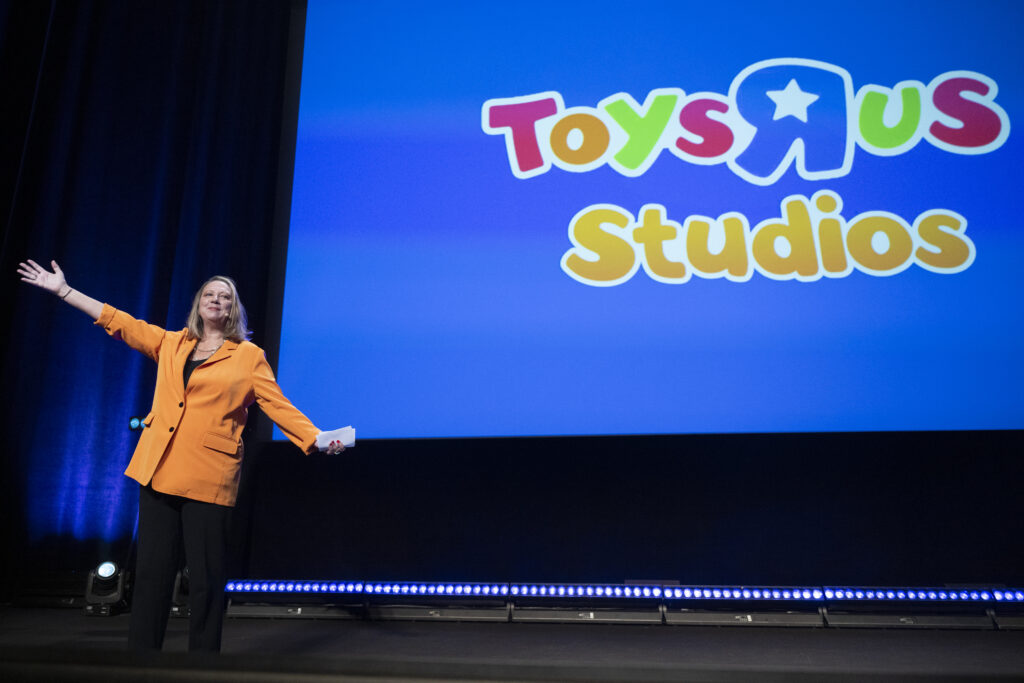
‘Content co-prods are us’ declares Toys”R”Us global CMO
And Geoffrey The Giraffe will be at the heart of its storytelling ambitions
Iconic kids retail brand Toys”R”Us is open to forging new content, having been through a major restructuring since WHP Global took control of the company in 2021.
“We’d love to talk to anybody about any ideas. We are definitely looking to co-produce and have some fun with partners,” was the message from Kim Miller Olko, global CMO of Toys”R”Us and president of its Toys”R”Us studios in her MIPJUNIOR keynote.
A familiar face is at the heart of the brand’s rejuvenated content strategy: mascot Geoffrey The Giraffe, who has already been featured in content promotions with YouTube star MrBeast and Broadway veterans the Blue Man Group.
The long-necked herbivore also appears briefly in the movie Kinda Pregnant, but is now lined up to star in his own feature film, with casting to be announced soon.
Miller Olko also enthused about two YouTube series, Geoffrey Vision and Geoffrey’s World Tour, which appear on the Toys”R”Us YouTube channel.
The first of those is already up to 48 episodes, which the brand is hoping to distribute internationally. Meanwhile, segments of Geoffrey’s World Tour, which sees the mascot meeting kids across the world, have been used as part of Nickelodeon series WhAM: What a Mess!
Toys”R”Us is also exploring how AI technologies can help its branded storytelling. Miller Olko explained that last year it created a branded video using OpenAI’s Sora GenAI video tool in partnership with prodco Native Foreign.
“We’re not changing into an AI studio, but it is definitely great to have it in our toolbox,” she said.
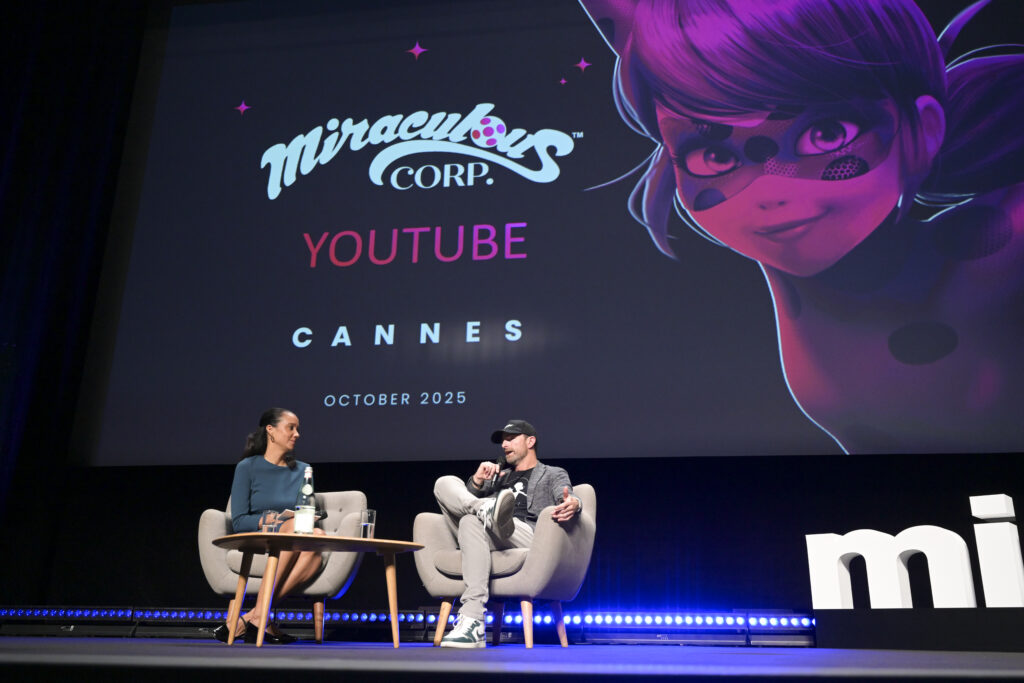
Multiplatform miracle workers explain the success of a kids megabrand
Miraculous Corp and YouTube talk windowing, formats and digital innovation
Tales of Ladybug & Cat Noir may be a global TV sensation on TF1 France and Disney platforms around the world, but YouTube has also helped to make it a multiplatform megabrand. Miraculous Corp CEO Andy Yeatman and YouTube’s global youth partnerships lead Alexis Rice explained how in a MIPJUNIOR headline session celebrating the IP’s first decade.
“The show, which is now in production on season seven, would not have existed without our broadcaster commissioning partners. But today we think of our strategy as multiplatform,” said Yeatman. “Miraculous is one of the most watched kids shows on TF1, Disney, Netflix, YouTube, Roblox, and many other platforms.”
Now the show is expanding, with plans including a movie, podcast and content for fans who have aged up. YouTube is also growing in prominence as a partner, with Miraculous recently starting to upload full episodes of the show to the platform – but only in a way that complements windowing arrangements with existing partners.
2D animation spin-off Miraculous Chibi will be on YouTube, TFI and Disney platforms, with plans for a crafting/makeover spin-off series, and a project called Malicious Secrets that Yeatman described as “Ladybug’s answer to Bridgerton or Gossip Girl”.
For her part, Rice said that TV “has been a big part of YouTube’s message this year”, including longer-form content. “The full-length episode, whole-family experience is something I’m seeing in a way I haven’t in past years,” she said.
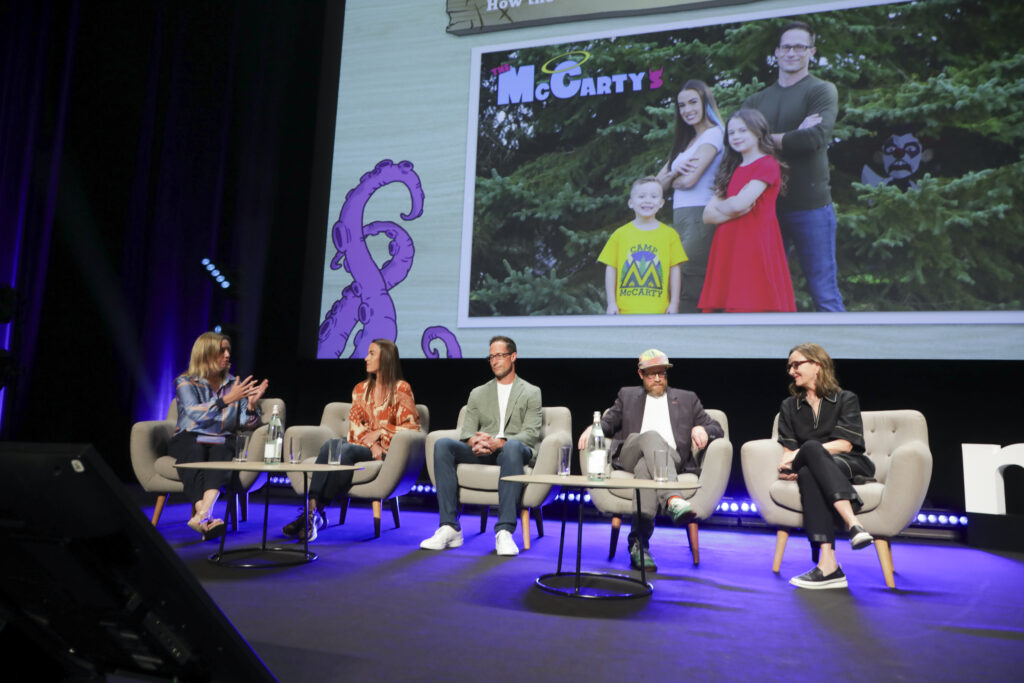
YouTube stars The McCartys make their move into animation
Kooky and spooky creators are ‘like the Addams Family meets Beetlejuice’
Some of YouTube’s biggest family-friendly stars were at MIPJUNIOR this weekend too. Stephanie and Kevin McCarty are a husband-and-wife team who make spooky live-action videos filled with Kevin’s monster characters – helped by their children Audriana and Braxton.
Now they are working with production company Wind Sun Sky Entertainment on an animated series brokered by Viral Nation head of programming Paul Telner, who joined the couple on their panel.
“I was looking through my roster of creators when I came across the McCartys. They were making some of the quirkiest, funniest, weirdest stuff I have seen on YouTube in years, so I got on a video call with them, and instantly fell in love,” he said. “Not only were they funny, they were interesting, and so hardworking.”
Wind Sun Sky CEO Catherine Winder took up the tale. “They had this amazing storytelling foundation. It was kooky, it was spooky, like the Addams Family meets Beetlejuice.”
There are ambitious plans to take the Camp McCarty concept beyond animation. Already, the partners have developed an event competition series concept called Camp McCarty: Escape If You Can. Stephanie McCarty said that audience feedback will remain a big driver for their creative ambitions.
“One of the great things about social media is you get all of this data in real-time,” she said. “We don’t have to sit around trying to figure out how something is going, because of the channel’s immediate feedback.”
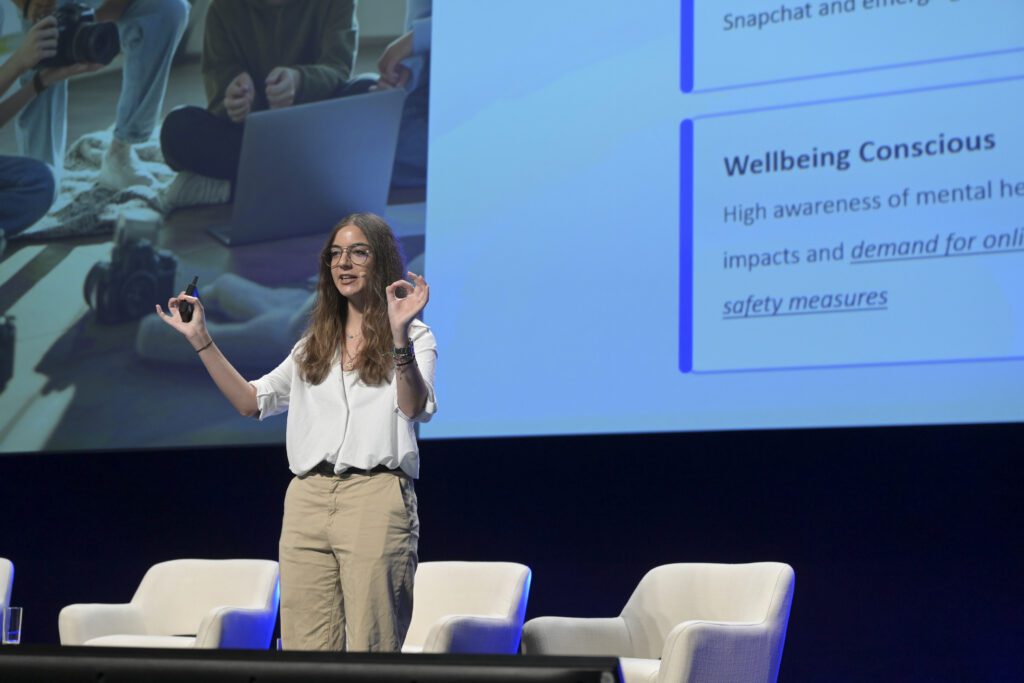
Where’s the next breakout for kids coming from? Try Roblox
But YouTube is still a powerful launchpad for new children’s IP too…
Will the next runaway children’s hit come from the traditional TV industry? Animaj co-founder Gregory Dray thinks not.
“I’m absolutely convinced that the next big children’s IP will come from a platform like Roblox,” said Dray during MIPJUNIOR’s ‘Knowing The Digital Youth’ session.
“This is the place where kids are spending an increasing amount of time. What I see today in Roblox is exactly what I was seeing when I was working for YouTube in 2014 and 2015… we are seeing some numbers that are absolutely astonishing.”
However, YouTube is still a powerful launchpad for new children’s IP and creators, suggested Chris M. Williams, CEO of pocket.watch.
“When channels grow on YouTube, they are coming through the most competitive environment in the history of time for content and IP. They are competing with 20m videos uploaded every single day, and 4.2bn videos on that library,” he said.
“When they come through the other side as creators, with millions of fans globally who love them, it is not luck. It’s not timing. It’s not because they gamed an algorithm. It’s magic.”
The session was led by Lea Karam (pictured above), founder of behavioural science consultancy Mindscope, who talked about the creative instincts of Gen-Z and Gen-Alpha kids.
“They watch content, but then they edit, they mash up, they transform the content. They create new narratives and new formats, they push into your IP, and they distribute the content across their communities,” she said.
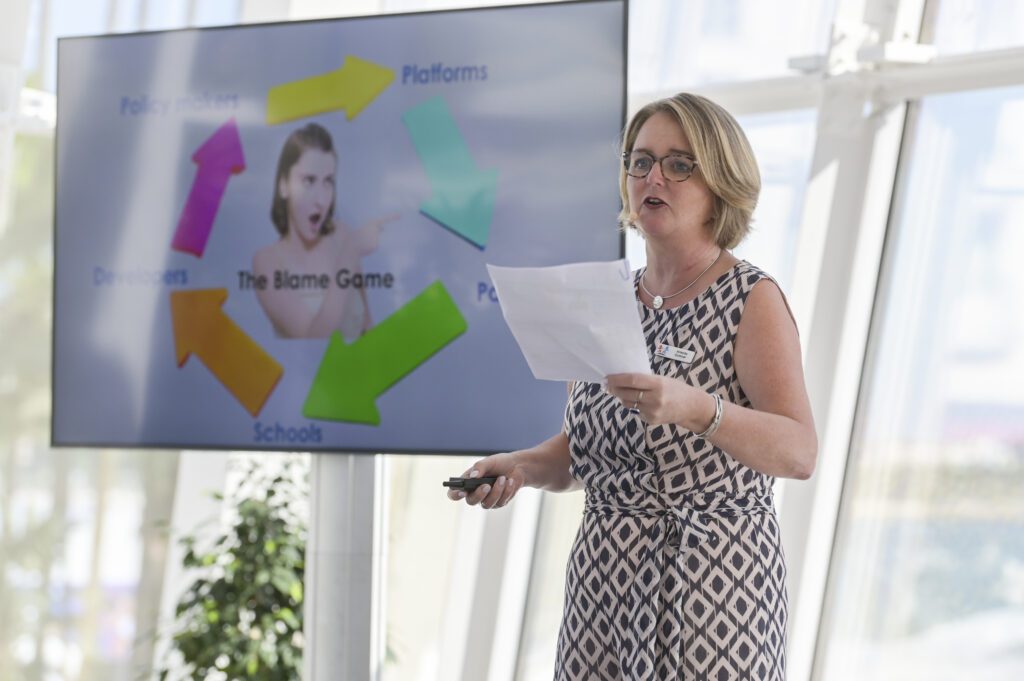
Why kids need imaginative content – including flights of fancy
Tapping into kids’ imagination is the key to making engaging, healthy content
The emphasis on kids’ creativity continued in a session from Fundamentally Children CEO Amanda Gummer on Saturday at MIPJUNIOR. She encouraged attendees to tap into the power of imagination in their shows, games and content.
“What is it that you can give them that empowers them? Things like building and storytelling, daydreaming and drawing,” she said. “That imaginative angle is how kids make sense of the world. It’s about giving them the opportunity to go on flights of fancy.”
Gummer’s session aimed to tackle “the elephant in the room” for the kids industry: the fact that children are spending ever more time on social-media apps and platforms where algorithms are aggressively driving their consumption.
“65% of eight-to-11 year-olds have their own social media accounts,” she noted. “The average screen time for a three-to-eight year-old is over five and a half hours a day. It is a scary place, but we can do something about it.”
What can be done? Gummer said that re-establishing the links between digital activity and physical play should be a high priority for the industry.
““TV content can encourage play. We’ve seen it with Bluey. It can help children thrive in a digital world, but also in the physical world,” she said. “Children today move fluidly between physical and digital play. You can learn a lot on the screen, but there are times when you need to be off the screen to learn other things.”
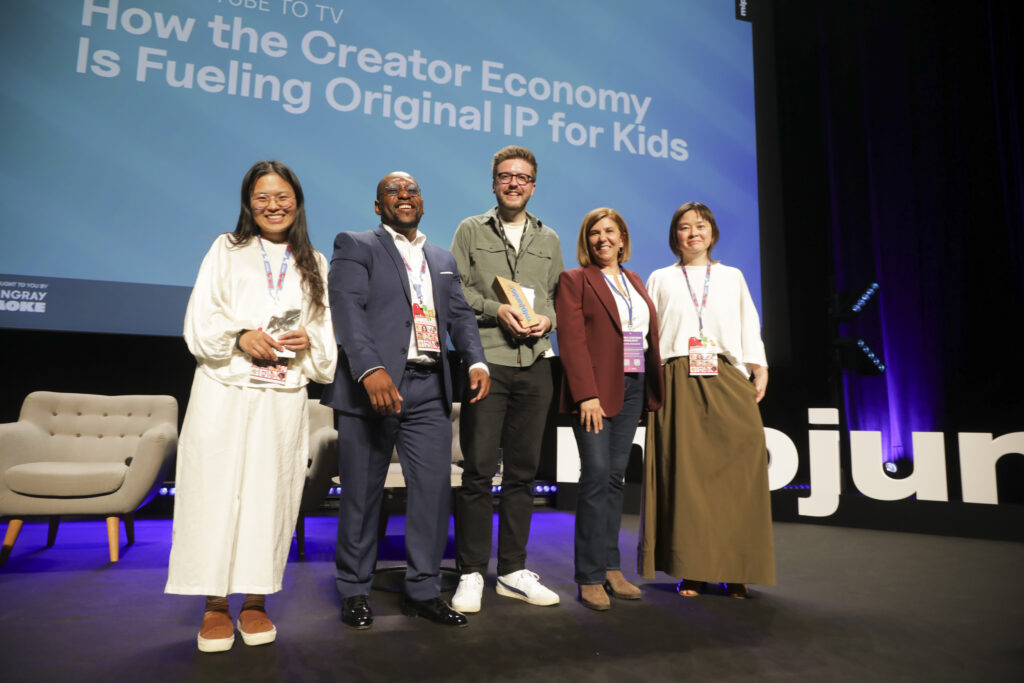
The Retrievers wins the 2025 MIPJUNIOR Pitch Kids/Tweens
Crime-fighting animal capers showcased alongside a diverse international field
Finally, this year’s MIPJUNIOR Pitch Kids/Tweens showcased some of the newest and most creative original formats aimed at 6-12 year-olds. The international competition saw a panel of top commissioners and licensing experts judging pitches for early-stage and in-development projects.
The winner was The Retrievers, a mystery comedy-adventure produced by Sixteen South in Northern Ireland. The 26 x 22 mins CGI-animated show stars a messy and impatient 11-year-old called Molly who discovers she can talk to animals – including police dog Otis. The pair form a crime-solving squad that also includes a rat, a seagull, a stray cat and a maggot, each with their own special abilities.
Development producer Stephen Coulter described it as “Scooby Doo meets Oceans 11, all set in a beautiful CGI world like Ratatouille”, and that certainly impressed the judges. It beat a distinguished and international slate of finalists to the prize.
Fox Fairy from China’s Buddha Studio is a beautiful, painterly animation following the fortunes of mythological fox demons. Meanwhile Izzi’s Super Fan Club from Brazilian firm Birdo tells the story of a young girl who works in the headquarters of her local superheroes. Mishaps ensue.
Ubuntu – Les Ambassadeurs de la Paix, from Armada Studio in the Côte d’Ivoire, aims to break sterotypes and educate viewers in a modern African setting. Last but not least, Yugi Bao from Spain’s Digitoonz Entertainment is a show set in the ‘Baoverse’ – home to tasty bao buns. The IP began with NFTs, but is expanding to encompass a cartoon, trading cards and other brand extensions.

